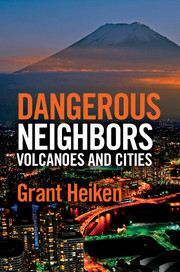Book contents
- Frontmatter
- Contents
- Preface
- Miscellaneous Frontmatter
- Introduction – dangerous neighbors: volcanoes near cities
- 1 Too many people and too many volcanoes – Naples, Italy
- 2 A full menu of volcanic hazards – Mexico City
- 3 “Like dangerous, yet undeniably beautiful women” – Guagua Pichincha and Cotopaxi volcanoes near Quito, Ecuador
- 4 Dangerous neighbors, but some bring gifts – Manila megacity, Philippines
- 5 “It’s part of the culture. Live with it!” – cities in Japan
- 6 Volcanic and proud of it – Auckland, New Zealand
- 7 Coffee, software, aircraft, and volcanic mudflows – Seattle, Tacoma, and Portland, USA
- 8 A tale of two cities – Akrotiri (island of Santorini, Greece) and Plymouth (island of Montserrat, Caribbean)
- 9 The dangerous neighbor is restless – how should a city respond?
- Recommendations for further reading
- Acknowledgements
- Index
4 - Dangerous neighbors, but some bring gifts – Manila megacity, Philippines
Published online by Cambridge University Press: 05 October 2013
- Frontmatter
- Contents
- Preface
- Miscellaneous Frontmatter
- Introduction – dangerous neighbors: volcanoes near cities
- 1 Too many people and too many volcanoes – Naples, Italy
- 2 A full menu of volcanic hazards – Mexico City
- 3 “Like dangerous, yet undeniably beautiful women” – Guagua Pichincha and Cotopaxi volcanoes near Quito, Ecuador
- 4 Dangerous neighbors, but some bring gifts – Manila megacity, Philippines
- 5 “It’s part of the culture. Live with it!” – cities in Japan
- 6 Volcanic and proud of it – Auckland, New Zealand
- 7 Coffee, software, aircraft, and volcanic mudflows – Seattle, Tacoma, and Portland, USA
- 8 A tale of two cities – Akrotiri (island of Santorini, Greece) and Plymouth (island of Montserrat, Caribbean)
- 9 The dangerous neighbor is restless – how should a city respond?
- Recommendations for further reading
- Acknowledgements
- Index
Summary
“I was in Manila 3 days later, on what some now call Ash Saturday. Roosters crowed at 3 p.m., and the sky darkened almost like night . . . because of volcanic ash that rose to a 18.5-mile altitude [from Mount Pinatubo]. Until then I had doubted Fr. Bencuchillo’s claim that during the 6-month eruption of 1754 [of Taal Volcano] Manila citizens carried lanterns at noon. Ash Saturday convinced me that the Spanish Priest hadn’t exaggerated.
– Thomas Hargrove, Bookmark Publishing, 1991More than 20 years ago, Dr. Thomas Hargrove, author and science editor at the International Rice Research Institute near Manila, witnessed the worst effects of the Pinatubo eruption on Manila, now a metropolitan area of 11.5 million people. During the previous 438 years of record keeping, Manila had been only minimally damaged by thin ash falls from neighboring volcanoes. As Hargrove described, when the ash is falling it is dramatically dark during the day and the ash is a terrible nuisance, but few lives were lost in Manila, a city overcrowded with cheek-by-jowl tenements and resort hotels that line Manila Bay. It even could be said that Manila benefits (albeit, rather) indirectly from the largest eruptions of its neighboring volcanoes. The business district of Makati, with its skyscrapers, is well above the bay and is located on a low plateau consisting of pyroclastic flow deposits from one or several of the geologically young calderas near Manila. In the event of earthquakes, Makati has an advantage because these volcanic units are less affected by ground acceleration. Parts of the city closer to Manila Bay overlie young, unconsolidated sediments, which do not provide a strong foundation for buildings during shaking. Given this situation, civic authorities rightly focus on the far greater hazards of typhoons, earthquakes, flooding, crime, and hunger; however, they must not overlook the threat from volcanoes.
- Type
- Chapter
- Information
- Dangerous Neighbors: Volcanoes and Cities , pp. 73 - 88Publisher: Cambridge University PressPrint publication year: 2013



